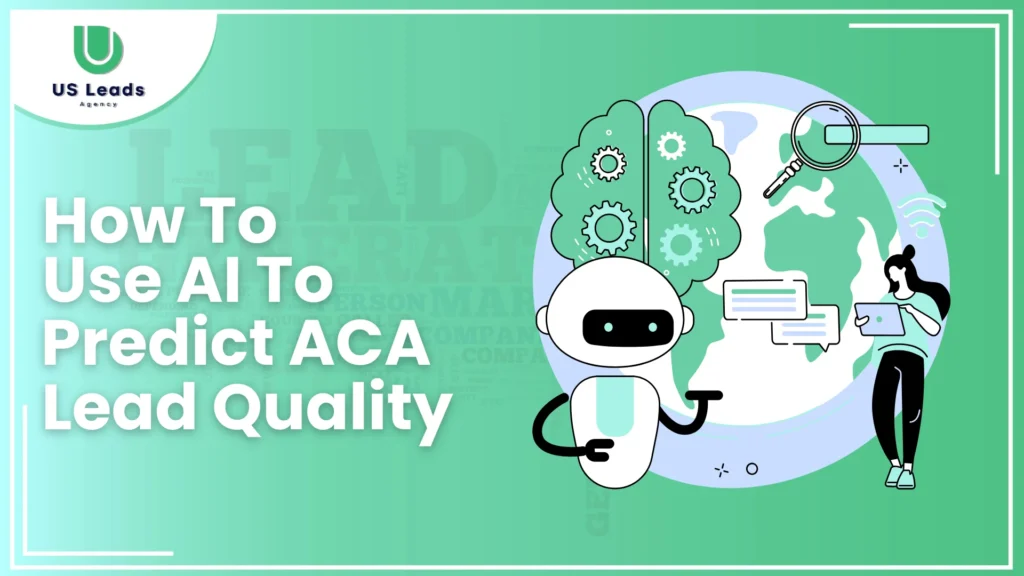
The Affordable Care Act (ACA) has reshaped how insurance providers connect with customers, but identifying high-quality leads remains a challenge. Artificial Intelligence (AI) offers a powerful solution, enabling providers to predict ACA lead quality with precision and scalability.
This guide explains how to use AI to predict ACA lead quality, ensuring your organization focuses on high-value prospects for maximum ROI.
Key Takeaways:
- AI-Powered Lead Scoring: Machine learning and predictive analytics identify high-quality leads efficiently.
- Critical Data Points: Engagement history, income eligibility, and location boost lead accuracy.
- Efficiency & Scalability: AI tools streamline lead management and handle high volumes.
- Ethical Compliance: Adhere to HIPAA and other privacy regulations for secure AI use.
Table of Contents
Understanding ACA Lead Quality:
High-quality ACA leads share specific traits:
- Eligibility: They meet ACA requirements, such as income or family size.
- Intent: Demonstrated interest in purchasing insurance.
- Demographic Fit: Align with your target audience.
Key indicators:
- Accurate contact details (phone, email, address).
- Income eligibility for ACA subsidies.
- Engagement history and interaction patterns.
- Geographical relevance to your service area.
Manually analyzing these indicators is labor-intensive. AI eliminates inefficiencies and ensures precision.
How To Use AI To Predict ACA Lead Quality?
AI leverages advanced algorithms to analyze data and predict outcomes. Key tools include:
- Machine Learning Models: Decision trees, random forests, and neural networks assess historical data to identify lead quality.
- Natural Language Processing (NLP): Analyzes chat logs, emails, and social media for insights into lead intent.
- Predictive Analytics: Uses past campaign performance to forecast conversion potential.
- AI-Integrated CRMs: Provide real-time insights and automated lead scoring.
Steps To Implement AI For ACA Lead Quality:
Step 1: Data Collection
Aggregate data from:
- Online forms
- Call center logs
- Email campaigns
- Social media interactions
Ensure accuracy and consistency in data preparation.
Step 2: Define Scoring Criteria
Collaborate with stakeholders to determine lead scoring metrics, including:
- Age
- Income level
- Employment status
- Health conditions
Step 3: Train Machine Learning Models
Use supervised learning techniques with labeled historical data to teach models the characteristics of high-quality leads.
Step 4: Deploy and Optimize
Integrate trained models into your CRM or lead management system. Continuously monitor KPIs such as lead conversion rates and model precision.
Benefits of AI In ACA Lead Prediction:
- Efficiency: Automates lead scoring, saving time and reducing manual errors.
- Accuracy: Delivers data-driven insights, minimizing biases.
- Personalization: Enables tailored communication based on user preferences.
- Scalability: Manages large datasets and high lead volumes seamlessly.
Challenges and Solutions:
- Data Privacy: Ensure compliance with HIPAA and other regulations by securing sensitive data.
- Algorithm Bias: Regularly audit and refine AI models to eliminate unintended biases.
- Cost Barriers: Start with affordable AI tools and scale based on proven ROI.
Real-World Applications of AI In ACA Lead Management:
- Insurance Brokers: AI evaluates subsidy eligibility to prioritize high-quality leads.
- Marketing Teams: Predictive analytics optimizes campaign targeting for better ROI.
- Call Centers: NLP tools enhance customer interactions and sentiment analysis.
Conclusion – How To Use AI To Predict ACA Lead Quality?
AI transforms ACA lead prediction, combining efficiency, precision, and scalability to optimize lead management strategies. By leveraging AI tools, organizations can prioritize high-value prospects, ensuring better targeting, higher ROI, and long-term growth. Embracing AI today sets the foundation for future success in ACA insurance markets.
FAQs:
How does AI improve lead quality prediction for ACA?
AI uses machine learning and predictive analytics to identify high-quality leads efficiently, reducing errors and improving targeting.
What data is essential for AI-powered lead prediction?
Data from online forms, call center logs, email campaigns, and social media is critical for accurate predictions.
How can small businesses implement AI affordably?
Start with scalable AI tools or pilot projects to prove ROI before expanding your implementation.
Is AI lead generation compliant with data privacy regulations?
Yes, as long as organizations adhere to HIPAA and relevant data protection laws.
What are the best AI tools for ACA lead prediction?
AI-powered CRMs, predictive analytics platforms, and NLP-based chat tools are highly effective in optimizing lead generation.
